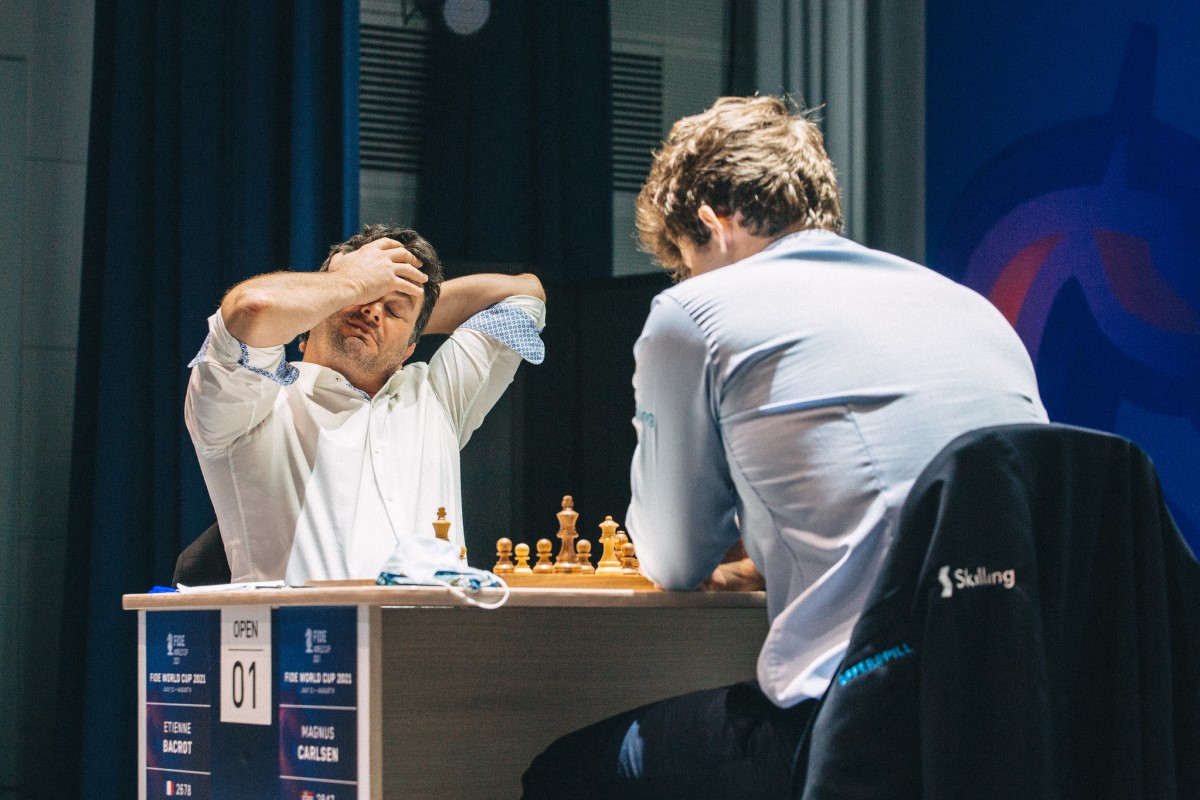


Barely making it past Andrey Esipenko in Tuesday’s tiebreakers seems to only have inspired Magnus Carlsen on his fourth attempt at winning the World Cup — he got his best result in 2007, when he lost in semis against Gata Kamsky. In the first game of the quarterfinals, the world champion beat Etienne Bacrot with the black pieces, showcasing excellent dynamic feel for the position in a double-edged struggle.
Bacrot did not shy away from entering a deep strategic battle, as he played the flexible 10.Bd2 instead of a more forcing line.
After thinking for almost a half hour, Carlsen responded with 10...Qd7, which demonstrates the richness of possibilities emerging from such a setup in the early middlegame.
The world champion later gave up a pawn, as he correctly assessed that he had more than enough compensation in a setup that resembled a position emerging from the Marshall Gambit. Bacrot had a far-from-comfortable position by move 26:
26.Qh3 was a mistake, as it allowed 26...c4, and White will need to make concessions in order to coordinate his pieces — it should be noted that, by then, it was already difficult to find moves for the Frenchman.
There followed 27.d4 Rde8 28.d5 (giving back the pawn to untangle) Qxd5 29.Rad1
And here Carlsen went for it with 29...Rxe4 30.Rxd5 Rxe1+ 31.Kf2 Rfe8 32.Re5 (only move) Bxe5 33.Kxe1 Bxc3+
Capturing with the bishop on move 32 was not optimal, but Black still has the upper hand in this position.
We let GM Karsten Müller take over at this point. In his annotations below, he shows that both contenders played imprecise moves shortly before the time control, although it was always going to be difficult to defend with white against Carlsen’s pair of bishops (see Jon Speelman’s column praising the Norwegian’s ability to handle this very strategic trump!).

It is never easy against the champ — Etienne Bacrot | Photo: Anastasiia Korolkova
Seeded 31st in the 206-player field, Sam Shankland arrived in Sochi shortly after winning a strong 8-player single round robin in Prague (ahead of Radoslaw Wojaszek and fellow quarterfinalist Jan-Krzysztof Duda). The American is still undefeated in the event, having needed tiebreaks only once while knocking out Baadur Jobava, Alexader Areshchenko, Rinat Jumabayev and Peter Svidler.
The Californian’s good form continues in the quarterfinals, as he made the most of Sergey Karjakin’s unexpected mistake on move 38.
After the unsightly 38...f5, White gets a decisive grip on the position thanks to his space advantage, as GM Müller demonstrates in his annotations below. Shankland showed great technique in conversion, correctly calculating that simplifying into a pawn endgame at the right time was winning for him.

Dreaming with the Candidates? He certainly has reasons to do so! — Sam Shankland | Photo: Eric Rosen
The first game to finish on Wednesday was Vidit vs Duda, as the players handled a Catalan Opening grandmasterly until reaching a 33-move draw. Already two well-known faces in the elite circuit, it would certainly be fitting to see either of the contenders in the next edition of the Candidates!
Not long after Vidit and Duda agreed to split the point, Amin Tabataei and Vladimir Fedoseev also signed a draw. Out of an Exchange Variation of the Queen’s Gambit, both players castled long and entered a complex middlegame. As chess historian Olimpiu G. Urcan captured on his tweet, both the game and the potential continuations in the final position were far from simple to discern.
Sometimes the game is easier to understand than the post-mortem. pic.twitter.com/WDNJCDMBQW
— Olimpiu G. Urcan (@olimpiuurcan) July 28, 2021
The semifinalists of the women’s tournament had a rest day on Wednesday, but they will join the 8 quarterfinalists of the open section tomorrow, when Bacrot and Karjakin will need to win on demand to remain in contention.
Select an entry from the list to switch between games

Fan favourite Vidit Gujrathi | Photo: Eric Rosen